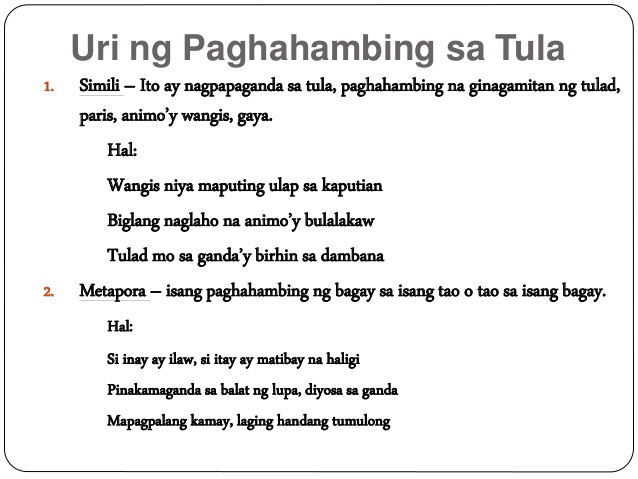Unlocking the Power of Comparison: Two Types in Filipino
Have you ever found yourself wanting to express similarities or differences between things in Tagalog? Perhaps you’re describing two equally delicious dishes or contrasting the height of two friends. In Filipino, the art of comparison (ano ang dalawang uri ng paghahambing) adds depth and nuance to your language. This exploration delves into the two fundamental types of comparison: pahambing na magkatulad (comparison of equals) and pahambing na di-magkatulad (comparison of unequals).
Understanding these two forms of comparison allows for more precise and expressive communication. Imagine trying to explain the subtle differences between two shades of blue without the tools to compare them! This is where the two types of "paghahambing" come into play, offering a framework to articulate those nuances effectively. They are essential building blocks for eloquent Tagalog, crucial for conveying complex ideas and engaging in meaningful conversations.
While the exact origins of these comparative structures are difficult to pinpoint, their presence reflects a universal human need to categorize and relate concepts. The ability to compare and contrast is not just a linguistic function, but a cognitive one, allowing us to understand the world around us by drawing connections and distinctions. These two types of comparison are deeply ingrained in Filipino grammar and are vital for effectively communicating relationships between objects, people, and ideas. Mastering these comparisons allows you to express yourself with greater clarity and precision.
One of the main issues related to understanding “ano ang dalawang uri ng paghahambing” is the potential for confusion between the two types. It’s important to grasp the subtle but significant differences in their usage. Misusing these comparisons can lead to miscommunication, particularly when describing nuanced differences or similarities. Understanding the specific markers and sentence structures for each type is crucial for avoiding these pitfalls.
Let's define the two types. "Pahambing na magkatulad" expresses equality or similarity between two entities. It utilizes words like "kasing," "sing," "magkasing," "magsing," and "ga." For example, "Siya ay kasingtangkad ni Maria" (She is as tall as Maria). On the other hand, "pahambing na di-magkatulad" indicates inequality or difference, using words like "mas," "higit na," "di-gaano," "di-kasing," and "di-sing." An example would be "Mas matangkad si Juan kaysa kay Pedro" (Juan is taller than Pedro). This distinction is crucial for accurately conveying the relationship you intend to express.
A benefit of understanding these comparisons is enhanced communication. You can articulate nuances effectively, avoiding ambiguity. Another advantage is improved reading comprehension. Recognizing these structures in written Filipino helps you grasp the author's intended meaning more accurately. Finally, mastering these comparisons elevates your writing, making it more descriptive and engaging. This precision allows you to paint vivid pictures with your words and express your thoughts with greater clarity and impact.
Advantages and Disadvantages of Mastering Paghahambing
| Advantages | Disadvantages |
|---|---|
| Enhanced Communication | Potential for Confusion (Initially) |
| Improved Reading Comprehension | Requires Practice and Attention to Detail |
| Elevated Writing Skills | - |
Frequently Asked Questions:
1. What does “ano ang dalawang uri ng paghahambing” mean? - It means "what are the two types of comparison?"
2. What is pahambing na magkatulad? - It is the comparative form expressing equality.
3. What is pahambing na di-magkatulad? - It is the comparative form expressing inequality.
4. How do I use "kasing" in a sentence? - Combine it with an adjective, like "kasingganda" (as beautiful as).
5. How do I use "mas" in a sentence? - Place it before the adjective, like "mas malaki" (bigger).
6. What are some common mistakes to avoid? - Confusing "kasing" and "mas," or incorrectly using "kaysa/kay."
7. Where can I find more examples? - Search online for "Filipino grammar comparison" or consult a Tagalog textbook.
8. Why is learning paghahambing important? - It strengthens your overall Tagalog comprehension and expression.
In conclusion, understanding and applying the two types of comparison in Filipino, pahambing na magkatulad and pahambing na di-magkatulad, is fundamental for effective communication. It empowers you to express nuanced comparisons, understand written text more deeply, and enhance your overall language skills. While mastering these concepts may require practice and attention to detail, the benefits are significant. From clarifying subtle differences to painting vivid descriptions, the ability to compare effectively enriches your communication and allows for more meaningful interactions. Embracing the power of comparison unlocks a new level of fluency and expression in Tagalog, opening doors to a richer understanding of the language and culture.
Boost birthday cheer with hilarious youtube songs
Elevated bathing exploring walk in shower designs with seats
The artful delight of paint party cupcake toppers

Gawain 12 Paghahambing sa patalastas na napanood Paghambingin ang | Innovate Stamford Now

Paggamit Ng Paghahambing Magkatulad At Di Magkatulad | Innovate Stamford Now

Dalawang Uri Ng Paghahambing Mga Halimbawa At Kahulugan | Innovate Stamford Now

Ano ang Paghahambing Halimbawa at Dalawang Uri Nito | Innovate Stamford Now

Ang Dalawang Uri NG Paghahambing | Innovate Stamford Now

Gawain sa Pagkatuto Bilang 4 Panuto Gamit ang Venn Diagram Talakayin | Innovate Stamford Now

May Dalawang Uri Ng Kaantasan Ang Paghahambing | Innovate Stamford Now

Dalawang Uri Ng Paghahambing Mga Halimbawa At Kahulugan | Innovate Stamford Now

ano ang dalawang uri ng paghahambing | Innovate Stamford Now

ano ang dalawang uri ng pantikan | Innovate Stamford Now

Panuto Sa pamamagitan ng Venn Diagram ay paghambingin ang dalawang uri | Innovate Stamford Now

Paghahambing Gamit ang Katagang Mas kaunti Mas Marami Magkapareho | Innovate Stamford Now

gamit ang dalawang uri ng paghahambing Magkatulad at di magkatulad na | Innovate Stamford Now

Gamit Ang Venn diagram paano mo maihahambing Ang URI ng pamumuhay ng | Innovate Stamford Now

Dalawang uri ng paghahambing | Innovate Stamford Now